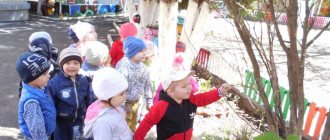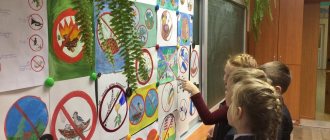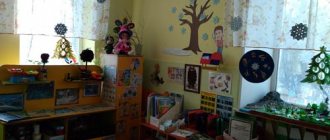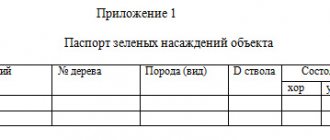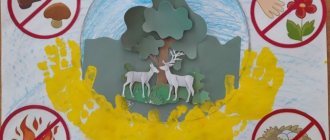Methodological development “Environmental education in preschool educational institutions”
MADOU Kindergarten No. 260 of the urban district of the city of Ufa of the Republic of Bashkortostan
Author: Avakumova Ekaterina Gennadievna, teacher of the senior group
"Environmental education of preschool children"
Nowadays, the problems of environmental education have come to the fore, and more and more attention is being paid to them. Why did these problems become relevant? The reason is human activity in nature, which is often illiterate, incorrect from an environmental point of view, wasteful, leading to a disruption of the ecological balance. Each of those who have caused and are causing harm to nature was once a child. That is why the role of preschool institutions in the environmental education of children, starting from an early age, is so great.
Preschool age is an important stage in the development of an individual’s ecological culture. At this age, the child begins to distinguish himself from the environment, an emotional and value-based attitude to the environment develops, and the foundations of the moral and ecological positions of the individual are formed. The process of forming the personality of a preschooler in general and environmental education in particular should be based on a system of knowledge that includes basic information about the biosphere (living nature: plants, animals, humans; inanimate nature.
Traditionally, in preschool education, the general process of mastering nature includes an element of its knowledge, the development of a humane attitude towards it and awareness of behavior in the natural sphere. Environmental education is the education of morality, spirituality, and intelligence. Man and nature: Philosophers, poets, artists of all times and peoples have paid tribute to this eternal and always relevant topic. But, perhaps, it has never been as acute as in our days, when the threat of an environmental crisis, and perhaps a catastrophe, hangs over humanity and the problem of greening human material and spiritual activity has become a vital necessity, one of the conditions for preserving what is common to all.
Environmental education in kindergarten promotes:
-Formation of objective ideas about the processes occurring in nature;
-Formation of a caring attitude towards nature.
Objectives of environmental education of children:
-To form an understanding that man is not the king of nature, but a part of it;
-Cultivate a desire to preserve your health and the environment;
-Explain the importance of natural resources in people's lives;
-Develop the skills of caring for all living things;
-Instill clear knowledge of how to behave in the forest, near bodies of water, in the park;
-Show the beauty of nature through the means of fine art.
-The formation of the beginnings of ecological culture in children, the development of environmental consciousness, thinking, and ecological culture in adults (educators, parents) raising them.
Developmental environment: Ecological path, laboratory, flower beds, educational garden, Dr. Aibolit’s corner (medicinal plants), living corners with animals: guinea pig, parrot, aquarium fish, plants.
S. N. Nikolaeva considers the essence of environmental education as the process of forming a consciously correct attitude of children towards natural objects with which they are in direct contact; awareness of oneself as a part of nature, understanding the value of life and health and their dependence on the state. All components of such an integrated approach to environmental education in a preschool institution do not exist separately, but are interconnected. Thus, a humane attitude towards nature arises in the process of realizing that the world around us is unique, in need of our care, and is consolidated in the process of practical activities to care for indoor plants, inhabitants of a living area, etc.
Revealing the beauty of nature to a child and teaching him to see it is a difficult task. To do this, the teacher himself must be able to live in harmony with nature, and the children must be ready to imitate his every move. They are very observant and attentive to the words of the teacher, they are good at distinguishing positive and negative in the actions of adults. Ecological education, sincere love for nature means not only a certain state of mind, the perception of its beauty, but also its understanding and knowledge.
Thus, the most important condition for the successful implementation of an integrated approach is the creation of an environment in which adults, by personal example, demonstrate to children the correct attitude towards nature and actively, to the best of their ability, participate together with children in environmental activities.
VIEW WORK
Methodological development for environmental education of preschool children
Municipal budgetary preschool educational institution "Kindergarten No. 20"
METHODOLOGICAL DEVELOPMENT ON THE TOPIC:
WORK WITH PARENTS ON ENVIRONMENTAL EDUCATION OF SENIOR PRESCHOOL CHILDREN
Completed by: teacher
Krivtsova Ekaterina Ruslanovna
Dzerzhinsk urban district
2019
2.1.Project “Working with parents on environmental education of older preschool children”………………………………………………………………………………….7
2.2. Long-term project plan…………………………………………..10
- Conclusion…………………………………………………………….13
- Literature……………………………………………………………………………….14
- Applications………………………………………………………………………………15
- INTRODUCTION
Working with parents on environmental education of preschool children is one of the components of the work of a preschool institution. After all, only by relying on the family, only by joint efforts can we solve the main task - raising a person with a capital “P”, an environmentally literate person.
Nowadays, the problems of environmental education have come to the fore and are receiving more and more attention. The reason lies in human activity in nature, often illiterate, incorrect from an environmental point of view, wasteful, leading to a disruption of the ecological balance.
The purpose of the work: the formation of the principles of ecological culture, the formation of a consciously correct attitude towards nature in all its diversity, towards the people who protect it; awareness of oneself as a part of nature; understanding the value of life and health and their dependence on the environment.
In working with parents on this problem, I solved the following problems:
- Reveal to parents the role of the family in nurturing the interests and positive attitude of a preschooler towards nature.
- Establish continuity in working with the family.
- Look for ways to naturally include the family in the process of introducing a preschooler to nature.
Expected results:
- Increasing the role of parents in the environmental education of children;
- Increasing the direct participation of parents and children in organizing and conducting various environmental events;
- Increasing the level of knowledge among parents and children about the ecology of their hometown and nature conservation.
Preschool age is the most important stage in the development of human ecological culture. During this period, the foundations of personality are laid, including a positive attitude towards nature and the surrounding world. At this age, the child begins to distinguish himself from the environment, an emotional and value-based attitude to the environment develops, and the foundations of the moral and ecological positions of the individual are formed, which are manifested in the child’s interactions with nature, in the awareness of inseparability with it. Thanks to this, it is possible for children to develop environmental knowledge, norms and rules for interacting with nature, develop empathy for it, and be active in solving some environmental problems. At the same time, the accumulation of knowledge in preschool children is not an end in itself. They are a necessary condition for developing an emotional, moral and effective attitude towards the world.
The family can take on part of the work of developing a moral attitude towards nature in preschoolers.
An analysis of family education shows that most parents consider familiarization with nature an important means of comprehensive education. At the same time, many are not aware of the problems that can be solved. “Getting to know nature happens on its own,” “We meet you on the way to kindergarten,” “We haven’t thought about it,” these are the parents’ answers.
A person who knows how to observe nature experiences aesthetic experiences. The natural world, with its unusualness, novelty, and brightness, has an emotional impact on a person, causing him surprise, joy, delight, and encouraging him to convey feelings in words and actions. But not everyone is able to deeply penetrate the world of natural beauty, perceive it and enjoy it. It is necessary to teach a child not only to look, but also to see, not only to listen, but also to heed, to cherish the beauty of nature.
Aesthetic ignorance negatively affects a child's intellectual and ethical development. Enriching ideas about nature, knowledge of its laws and connections is impossible without an emotionally positive attitude towards it, therefore all communication with nature of a small child should be aimed at nurturing his emotional responsiveness, the ability to notice and appreciate the beauty of nature. At the same time, there is another danger: to teach people to formally communicate with nature, limiting themselves to either utilitarian activities (picking mushrooms, berries, flowers) or sports and recreational activities (swimming, playing in nature, etc.).
When working with parents, it is important to emphasize that before a walk “into nature”, at least a small goal is outlined related to the perception of an object of nature (to admire, take a closer look, notice, compare, remember, etc.).
2. MAIN PART
In my practice I use the following forms of working with parents on environmental education:
- Questionnaires, conducting surveys to identify their environmental competence;
- Round table conversations “Let's save our native nature”, parent meetings “Environmental education of children in kindergarten and at home”, “Wonders of living nature” in an unconventional form (talk shows, business games, pedagogical services bureau, direct telephone),
- Conversations and messages with an environmental focus for the parent corner. (“Ecological passport”, “Ecological situation”, “The problem of “child’s health - environment””, “Help the tits”, “Birds and people”, “They stayed for the winter, we will help them”).
- Calendar of interesting dates - joint leisure activities, holidays (“Bird Day”), KVNs, quizzes, etc.
- Homework - participation in exhibitions, competitions, etc. (“Food for different birds”, “Forest canteen”, “Whose food tastes better”, “My pet”)
- Involving parents in joint work with their children on the site and in the corner of nature.
- The use of popular scientific methodological literature on the problems of environmental education.
- Production of newspapers, photo newspapers, environmental albums, posters, folders, papers.
- Compiling an album “Me and Nature” for each child throughout the year. Here are children's drawings, photographs taken during excursions, hikes, visits to summer cottages, trips to the village, etc. Parents record their children's statements, funny incidents and stories related to nature. Children in the group can talk about what new they learned, saw, where they visited, and comment on a photograph or drawing.
- Development of a series of prohibitory and permitting signs. The first of them (red) reflect human actions that can harm nature and which a person should not commit. The second - resolving (green) - depicts everything that has a beneficial effect on nature and contributes to its good condition. During the walk, children can hang signs around the site and tell children from other groups about them.
- Repairing old books and collecting waste paper. Children already know that paper is made from wood. This means that the longer paper things serve people, the more trees will remain in the forests. You can arrange an exhibition of books repaired together with your parents. Donate waste paper and use the funds received to buy new books, shovels, rakes, etc.
When choosing a particular form of work, you should pay attention to the contingent of parents, their interests, activities, creativity and capabilities. That is, as in the work of educating preschoolers, adhere to an individual approach. Traditional forms of work are designed for a wide range of people and are not always effective and efficient. As for non-traditional forms of work, here, with the help of a differentiated approach to working with parents, the effectiveness and efficiency of work increases, provided that the teacher finds and applies the right ways of interaction and work.
It is also important when communicating with parents to build a correct dialogue. Edifications, clear instructions, conventions, frameworks, specifics - everything that our parents receive every day at work leads to the fact that a positive response can be expected only from a small proportion of parents. And we need an emotional response, a desire to help and work together in a given direction. A positive attitude, a differentiated approach and a variety of forms of work will help to attract parents to joint activities, solving important problems and finding common correct solutions.
- . PROJECT “WORK WITH PARENTS ON ENVIRONMENTAL EDUCATION OF SENIOR PRESCHOOL CHILDREN”
Relevance of the project: due to the high level of environmental pollution and the low level of environmental culture of the population, much attention is paid to environmental education in Russia. Emphasis is placed on environmental education of all segments of the population.
The first stage of environmental education is preschool educational institutions. It is in preschool childhood that the foundations of environmental culture are laid. But cultivating a correct attitude towards nature, the ability to handle living objects of nature, can be fully implemented only if the system of work in a kindergarten is combined with influence on the child in the family.
The teacher’s task: together with the family, give children basic scientific knowledge about nature, maintain interest in learning about the environment, and teach them to empathize with living beings.
Conversations with parents revealed a great desire to introduce children to the nature of their native land, but at the same time showed a low level of environmental competence.
The example of parents is of considerable importance in the upbringing of preschool children. It was decided to begin environmental education of preschoolers by creating a project to work with parents, so that by their example adults could convey the importance of the problem of protecting nature to their children.
The project method allows you to combine the interests of all participants in the educational process: children, parents and teachers.
The goal of the project: the formation of environmental competence and environmental activities of parents in improving the quality of the environment and in nurturing an environmental culture in children.
Project objectives:
- To bring to an understanding of the importance of the problem of the relationship between man and nature and the consequences of human activity in it.
- To expand the understanding of parents that nothing in nature disappears without a trace and it is very important to teach the child to protect nature, love it and be able to protect it.
- Raise the level of environmental culture and awareness of parents about the problem of waste management through information messages.
- Arouse interest in creating a favorable environment.
- To form child-parent relationships in the spirit of nurturing interest and environmentally correct behavior in nature.
- Teach parents, by personal example, to treat nature with care, protect it, and protect it.
- Summarize and systematize accumulated experience, knowledge and materials.
Means of project implementation:
Information cooperation:
- Conversations.
- Consultations.
- Folders are sliding, folders are clamshells.
- Presentations.
Cooperative activity:
- Subbotniks.
- Ecological holidays.
- Round table.
- Landscaping of the site
Expected results:
- Strong participation of parents in the environmental education of children;
- Direct participation of parents and children in organizing various environmental events;
- Increasing the level of knowledge among parents and children about ecology and nature conservation;
- Group albums “We relax without harming”, landscaping and landscaping of the kindergarten area;
Type of project: creative.
Participants: parents, children, teachers.
Material and technical resources: photo albums, whatman paper, gouache, flower seeds, container for planting seedlings, garbage bags, presentation material, projector.
Project implementation stages:
Preparatory:
- Justification of the relevance of the topic, motivation for its choice;
- Formulating the goals and objectives of the project;
- Selection and development of methodological literature;
- Analysis and generalization of existing experience on the stated topic;
- Formation of motivational readiness of parents to participate in the project;
- Development of a long-term work plan;
Practical
: carrying out activities according to the long-term plan
Presentation:
- Project presentation.
- Summarizing.
Presentation of the project: Ecological holiday “We are defenders of nature.”
2.2.LONG-TERM PROJECT PLAN
October
- Conduct a parent meeting “Environmental education of children in kindergarten and at home” in order to attract parents to participate in the project. Conduct a conversation with parents with a preliminary questionnaire on the topic “Take care of nature.”
- Create family archives “Let’s relax without harming!” (family photos – outdoor recreation: park, forest, country house).
- Group excursions with children and parents around the city “Weekend Club”.
- Set up a photo stand in the “Nature of our city” group.
- Involve parents in creating a wall newspaper dedicated to nature conservation.
November
- Conduct a conversation “Garbage is problem No. 1.” The goal is to convey to parents how important this problem is in our city. Talk about ways to process waste and the possibilities of recycling it. Show with examples the damage waste causes to a city.
- Together with parents, create advertising leaflets for trash cans on the topics: “Let the city be clean!” “Give me the trash!” and so on.
- “Weekend Club” - conduct environmental excursions around the city together with children and parents.
- Involve parents in replenishing a corner of nature in a group to create lapbooks on ecology, models of climatic zones of Russia, and a nature calendar.
- Create a booklet for parents: “Where should I put the trash?” — inform adults about where they can take industrial waste for recycling in our city.
December
- Develop and create, together with parents, a brochure on the topic “How to teach a child to protect nature.”
- “Ecological landing” - to carry out walks around the city together with parents and children in order to collect plastic.
- Homework for parents “Waste as a resource” (involvement in collecting plastic waste).
January
- Prepare information for a stand in the parent’s corner “The influence of nature on the spiritual development of a child.”
- Together with the children, prepare instructions for parents “Down with garbage!”, “Don’t throw garbage anywhere!”
- “Ecological landing” - involve parents in collecting plastic waste.
- Competition for parents for the best leaflet on the topic “Let's make our city cleaner.”
February
- Conduct a conversation for parents “Nature and moral education of children of senior preschool age.”
- Hold a competition for parents for the best environmental game for children.
- Create a mobile LAPBUK folder for the parent’s corner “Love and protect the environment.”
- Make a photo album from family archives “How we relax in nature (dacha, forest, etc.).
March
- “Weekend Club” - a speech by parents on the topic “The House We Live In.” With the help of this conversation, we would like to find out from the parents what their local area looks like, what their entrances look like, what they do to improve their appearance, and do they do it at all? What could or would like to be done to improve the surrounding areas?
- “Weekend Club” - take ecological walks around the city together with your parents.
- Homework is to come up with fairy tales, ditties, and chants on environmental topics.
- Drawing competition for parents and children on the theme “My beautiful, clean city!”
April
- Walk-observation on the theme “Spring has come. Is the city clean?
- Conduct a conversation with parents on the topic “Animals in the city.” Many of us have pets, and in the spring, on the lawns, we see the remains of their vital activity. It all looks terrible. We would like to ask parents how they feel about this problem and what they think could be done.
- “Ecological landing” - together with parents, hold a cleanup day to clean the territory of the kindergarten.
- Preparing a booklet “Did you know that...” (How long does it take for various types of garbage to decompose: paper, glass, plastic).
May
- “Weekend Club” - hold a conversation with parents on the topic “Fire is a disaster for the forest!” Summer will begin soon, and we will all go on vacation outside the city. But do we all know how to behave correctly in the forest? With this message, we would like to warn parents about the harm that an accidentally forgotten fire, a thrown cigarette, etc. can cause to nature.
- “Ecological landing” - hold a cleanup day with parents to plant landscaping in the kindergarten area.
- Make a photo stand from photographs about the cleanup event “That’s how it became green!”
- Prepare and hold an environmental holiday “We are friends of nature!” for children with the participation of parents.
Project results:
During the implementation of the project, I came to the conclusion that such events unite children and parents with common activities, impressions, experiences, and emotions; contribute to the formation of child-parent relationships in the spirit of nurturing interest and environmentally correct behavior in nature. The project expanded the ideas of parents that nothing in nature disappears without a trace and it is very important to teach a child to protect nature, love it and be able to protect it; increased interest in creating a favorable environment in his hometown; With the help of the project, using personal example, she created in parents the awareness that they need to treat nature with care, protect and protect it.
3.CONCLUSION
Cooperation with children's families on environmental issues and jointly organized events not only helped to ensure the unity and continuity of the pedagogical process, but also introduced into this process the special positive emotional coloring necessary for the child.
Only through joint efforts we were able to solve the main task - to raise an environmentally literate person. Children are our future, and if they grow up not indifferent to birds, insects, trees, flowers, the bright sun and an elegant rainbow, ready to defend a weak chick or an abandoned kitten, then our efforts and concerns were not in vain. And then maybe in our country the air will become a little cleaner, there will be a little less stray animals, the rivers will become deeper and clearer, and the people will be kinder.
The remarkable teacher V. A. Sukhomlinsky wrote: “Man was and always remains a son of nature, and what makes him related to nature should be used to introduce him to nature, to the riches of spiritual culture. The world surrounding a child is, first of all, the world of nature with an endless wealth of phenomena, with inexhaustible beauty. Here, in nature, is the eternal source of children’s intelligence.”
4. LITERATURE
- Golitsyna N.S. Environmental education of preschool children. Long-term planning of work with children 3-7 years old: Methodological manual. – M.: Mosaika-Sintez, 2006.
- Ivanova A.I. Living ecology: Environmental education program for preschool children. – M.: TC Sfera, 2009.
- Kameneva L.A., Kondratyeva N.N. The natural world and the child. Methods of environmental education of preschool children: Textbook. – St. Petersburg: Detstvo-Press, 2007.
- Kolomina N.V. Education of the fundamentals of ecological culture in kindergarten. Lesson scenarios. – M.: TC Sfera, 2005.
- "We". Program of environmental education for children / N. N. Kondratyeva et al. - St. Petersburg: Detstvo-Press, 2003.
- Nikolaeva S.N. Methods of environmental education of preschool children: Textbook. – M.: Academy, 2009.
- Nikolaeva S.N. Theory and methodology of environmental education for children. – M.: Academy, 2002.
- Nikolaeva S.N. Environmental education of preschool children // Pedagogy. 2007. - No. 5. - P. 22-27.
- FROM BIRTH TO SCHOOL. Basic educational program for preschool education / Ed. N.E. Veraksy, T.S. Komarova, M.A. Vasilyeva. – 4th ed., revised. – M.: MOSAIC-SYNTHESIS, 2021. – 352 p.
- Polomoshnova O.Yu. On the environmental education of preschoolers // Primary school plus Before and After. - 2008. - No. 2. - P. 47-49.
- Solomennikova O.A. Introduction to nature in kindergarten. Senior group. - M.: MOSAIC-SYNTHESIS, 2015
APPLICATIONS
Annex 1
Questionnaire for parents “How competent are you in environmental issues?”
- FULL NAME.
- Do you think it is necessary to introduce children to the nature of our city?
- Do you think there are environmental problems in our city? Which?
- In your opinion, do you have enough information about the nature of our city to answer the questions your child has?
- How often do you and your child go on outdoor trips?
- Do you think your child is familiar with the rules of behavior in nature? And you?
- What events could you propose to hold on environmental topics in a group or for the city?
- Do you think there are problems related to household waste in our city? Which?
- Are there animals or plants in your house? Is your child involved in their care? Does he know how to care?
- Does your child work in the garden? How does he do this: willingly, with joy, or indifferent to work in nature?
- Do you have children's books about nature in your home? What books are these? Does your child like to watch nature programs on TV?
- Does your family use manual labor?
- Does your child know anything about conservation? Does he recognize plants that are subject to protection (for example, lily of the valley, kupavnitsa, marigold, bellflower, etc.) in a forest or park?
Appendix 2
Conversation for parents on the topic “Nature and moral education of children of senior preschool age”
When V. Bianchi was asked why he writes about forests, fields, animals and birds, he recalled his childhood, the Zoological Museum, where his father took him, and the painful desire to find magic words that would disenchant these long-vanished animals. Humanity is now fighting to ensure that our Earth does not turn into a huge “Zoological Museum”, so that each next generation treats nature more carefully than the previous one.
Nature is not an endless warehouse, its reserves are exhaustible, therefore human activity in nature must be reasonable: protective and creative.
This attitude towards nature must be instilled in children from an early age. It is from these years that a person begins to experience the beauty and diversity of nature.
It is necessary to instill a love of nature from an early age for two reasons: firstly, to cultivate a caring attitude towards the animal and plant world; secondly, for the development of more complex moral feelings and qualities: kindness, sympathy. A child’s behavior in nature is sometimes contradictory: having a positive attitude towards objects of nature, children often commit negative actions (plucking flowers they like and immediately throwing them away, tormenting and “petting” a kitten, etc.).
Sometimes they mistakenly think that the emotional impact of nature is a natural basis for cultivating a positive attitude towards it. A deep, conscious feeling of love and humane attitude towards it is not born from an external attitude towards nature, but can only be born. An interesting example is given in B. Ryabinin’s book “On Love for Living Things.” “The child is scaring the pigeons. At first glance, an innocent activity. But he has fun by scaring him, he likes that the pigeons flap their wings when he approaches and fly away, that they are afraid of him - and this is where, as they say, the dog is buried, here is the root and root cause of evil.”
The guidance of an adult is necessary so that the external emotional attitude towards nature develops into a moral and aesthetic feeling, which presupposes an active, effective position of the child.
Teachers working with preschoolers note that children have an insufficiently developed proactive, independent attitude towards natural objects. A child will not offend a lonely kitten he sees on the street, but he will not help it either; will not break tree branches, but will not tie up broken ones. Solving such problems as cultivating an effective attitude towards the environment and developing skills in caring for animals and plants depends on the coordination of efforts and the unity of the requirements of the kindergarten and family.
A preschooler often has selfish and utilitarian motives for communicating with objects of nature (“I like to play with the dog,” “I wrap my cat in a blanket and tie bows,” “I like to go to the forest and pick mushrooms with my dad”), but they are nevertheless available to him. good deeds, selfless work. The presence of knowledge does not yet indicate a child’s conscious and sustainable positive attitude towards nature. Why is it so important to include your child in the daily care of plants and animals? Those at home: “Check if the soil in the flower pots is dry,” “Prepare food for the parrot,” “Feed the dog,” “Change the cat’s water,” “Sow oats to feed the birds,” etc.
Watching TV shows about animals is of great importance. Is it good if parents watch the program first and pay attention to that material? Which will be interesting to the child, they think through an accessible commentary and, when repeating the program, watch it together with the child.
During walks, it is interesting to show children the plants listed in the Red Book, introduce the children to medicinal herbs, and tell them why they are called that. Children easily remember names such as coltsfoot, valerian, plantain, etc. After such conversations, they treat plants with care, even widespread ones.
Thus, every child should know well the rules for handling natural objects. It is advisable that these rules are formulated not in a negative form (“do not tear”, “do not trample”, “do not break”), but in a positive form (how to help, care, protect).
It is important to create an emotional contact between the child and nature: let him wander around on his own, find something unusual, sit quietly on a hillock, listen to the singing of birds or the murmur of a stream, or just look around him.
Of course, a child’s emotional attitude to nature is largely determined by the attitude of the adult himself, so it’s good when parents know a lot of poems, songs, and riddles about nature and use them during walks and observations. The relationship between the ethical and the aesthetic contributes to the formation of an effective love for nature.
Appendix 3
Material for the information stand for parents on the topic “The influence of nature on the spiritual development of a child”
- K.D. Ushinsky was convinced that the child was unhappy who grew up without seeing meadows or admiring wildflowers. “Call me a barbarian in pedagogy,” he wrote, “but I have learned from the impressions of my life a deep conviction that a beautiful landscape has such a huge educational influence on the development of a young soul that it is difficult to compete with the influence of a teacher.”
- In the old days there was such a custom: a cat was slipped to the groom who came to the house. If he stroked an animal, played with it, a kind person had come; if he treated him rudely, they were wary, since the attitude towards a person is also checked in relation to an animal.
- Does a child’s knowledge of nature affect more than just the realm of the mind? But also the area of moral feelings. Therefore, while imparting to children knowledge about the animal and plant world, adults simultaneously communicate the rules of behavior in the natural environment. The rules are transmitted to preschoolers in a specific life situation, with the help of the explanation of the mother or father, and as a result of the influence of fiction.
- It is advisable to connect observations and walks in nature with other activities: reading books about plants and animals, drawing, storytelling. An adult creates conditions so that children’s knowledge is complete and deep and is correctly applied by them in various activities. It’s good when poems about nature are often heard in the house, and in the evenings children and their parents look at reproductions of paintings by I.I. Levitan, A.I. Kuindzhi, K.F. Yuon, N.M. Romadin, A.A. Plastov and other artists, they themselves come up with simple poems and songs about nature.
- It is useful to have one of the animals in the house: a dog, a cat, fish, chickens, etc. A child can emotionally communicate with animals: play and talk. At the same time, parents are an example for children of a caring, attentive attitude towards animals; they explain to them the dependence of the animal’s well-being on the child’s fulfillment of the task of caring for it.
- You came with your child to the autumn forest. Ask him which forest he likes better - autumn or summer? Why? What colors would he use if he were an artist and painted a picture of an autumn forest?
- Draw the child’s attention to the fact that a person’s mood often depends on the weather conditions and natural phenomena.
“When it rains outside,” says six-year-old Denis, “I get bored and don’t want to do anything.”
“What do you think,” Father asks Dasha, “what mood do people have in the spring?”
“Joyful,” the daughter answers. “Everyone is glad that the cold winter is over and summer will soon be here.”
- And if you were a composer, what kind of music would you come up with about spring - sad or cheerful?
“Of course, cheerful, sunny and flowing,” Dasha answered.
20

